|
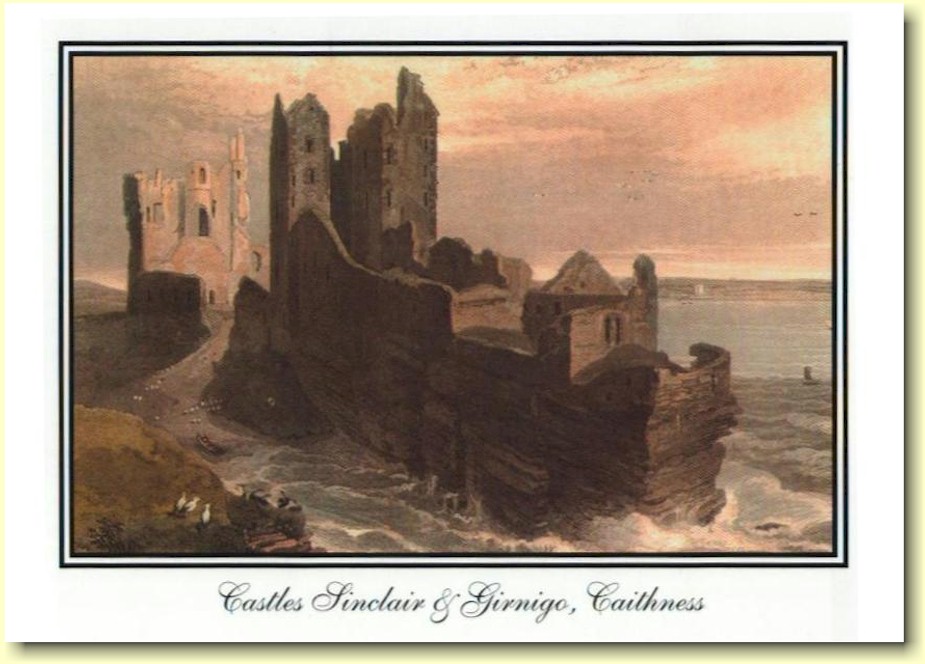
|
| |
 |
Translation
into English by
Norman Henderson |
 |
|
| |
|
|
|
|
| |
Web:
Geir Neverdal (lektor/cand.philol) - Sel Historielag |
|
| |
|
|
|
|
|
|
|
|
|
| |
Connections
with Scotland |
|
| |
|
|
| |
|
|
|
|
|
|
|
|
|
| |
|
|
|
Background - The
Battle - Myths?
- Significance - Objects - Literature - Scotland
-
Programme2012 |
| |
|
|
| |
|
|
| |
Connections between Norway and Scotland have
been close - and
important - since the early Viking era.
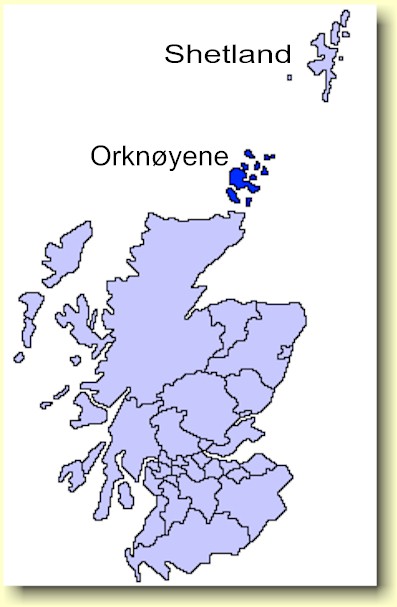
1)
The Orkney Islands, Shetland og Scotland
The Orkney Islands and Shetland were populated
by Norwegians towards the end of the 8th and the
first half of the 9th centuries AD.
In
relation to that times standards, Norway began
to be overpopulated, and the availability of
natural resourses and land for cultivation were
reduced.
The
Norwegians who arrived in the Orkneys forced the
original inhabitants the Picts out, and Norrønt/Norwegian
became the spoken language of the Islands.
After Harald Hårfagre (Harald Fairhair) had
united Norway into one nation, many of his
opponents left the country, and some established
themselves on the Orkney Islands. From here they
carried out raids, plundering both Scotland and
Norway.
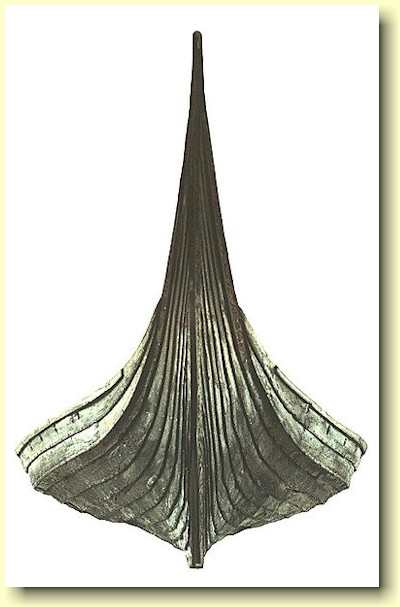 This
resulted in Harald Hårfagre forming a large
fleet and around the This
resulted in Harald Hårfagre forming a large
fleet and around the
year 875 Harald and his men took control of, and
annexed, both the
Orkney and Shetland Islands. Both these island
groups were then
established as an Earldom governed by Rangvald
Mørejarl. Harald gave
the Orkney Islands and Shetland (then known as
Hjaltland) to Rangvald
Mørejarl as compensation for the loss of his
unmarried son Ivar, who
had been killed in battle in Scotland. Rangvald
Mørejarl passed the
islands on to his brother Sigurd Eysteinsson,
who was known as Sigurd den mektige (Sigurd the
Mighty).
(Wikipedia)
2)
The
Normans
Gangerolv, Rangvald
Mørejarl's son, conquered
Normandie and many
Norwegians, including himself, remained and
lived there in the 10th century. One of his
decendants was Vilhelm Erobreren (William the
Conqueror), who invaded England in 1066.
One
of his men from Normandie was the founding
ancestor of the Clan Sinclair. Another of his
decendants later became Jarl av Orkney, and from
1455(?)
Jarl av Katanes (Earl of Caithness). This
title is also used by the present Clan Chief,
Malcolm Sinclair.
The illustrations to the
right are borrowed from Wikipedia.
More about this follows.
|
|
| |
|
|
|
|
|
|
|
|
| |
|
|
| |
1)
The Viking Era ca 800-1050
Apart from
these warring activities, there existed a more peaceful
colonisation of the islands to the West.
Norwegians occupied
the Orkney Islands,
Shetland (Hjaltland), the
Isle of Man and the
Hebrides (Norroent Suðreyjar). The North
of Scotland and Ireland were also
areas of interest to the Norwegians.
Dublin was founded by Vikings in the 840s and was the
seat of a Nordic kingdom until 1171, writes Bergljot
Solberg in
Store norske leksikon. |
|
| |
|
|
|
| |
|
|
|
| |
The
Norwegian/Norrønt (Old Norse) language existed for a
long time
|
|
| |
An attempt
has been made on this map to show where Norwegian/Ol
Norse was spoken.
Angell
maintains:
"One has only to read the Orkney Islands Saga
and our own Kings Sagas to see how strong and close
the connections were between these aforementioned
Scottish areas and the nearby Norwegian islands as
well as with the old country. One doesn't have to go
there to see the similarity between the Norwegian
and Scottish languages, or to hear it in the tone;
one can easily see it in the names of places and
people, read it out of the folksongs which still
survive. Fadervoret (Our Father) is to be found on
the island on the other side of the Pentland Firth,
and is still quite clearly Norwegian, that is old
Norwegian. In a newly published historical work
about St. Clairætten (i.e. the Sinclair family) it
is written that in districts of the old Norwegian
settlement areas, Norwegian was still spoken as late
as the latter half of the 18th century. Norwegian
was not driven out of the schools before then.
(p.28)
"after hearing this, one can perhaps understand
that the claim, put forward in Gudbrandsdalen, that
Sinclair and many of his men could understand
Norwegian, isn't so unreasonable. (p.29)
|
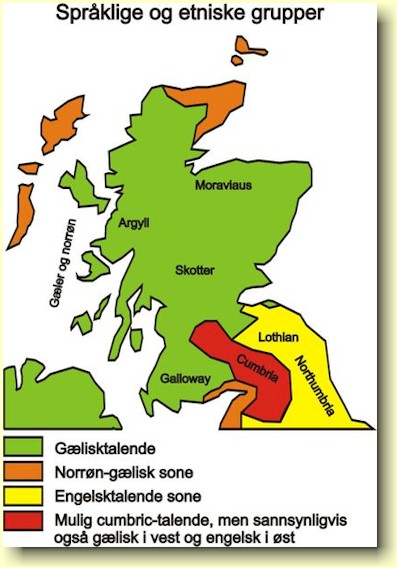
Language distribution early in the 1100s in
Scotland:
Gaelic-speaking
Old Norse/Gaelic area
English-speaking area
Possible Cumbric-speaking, but probably also Gaelic
in the West and English in the East.
The illustration is
borrowed from Wikipedia.
|
| |
|
|
| |
|
|
|
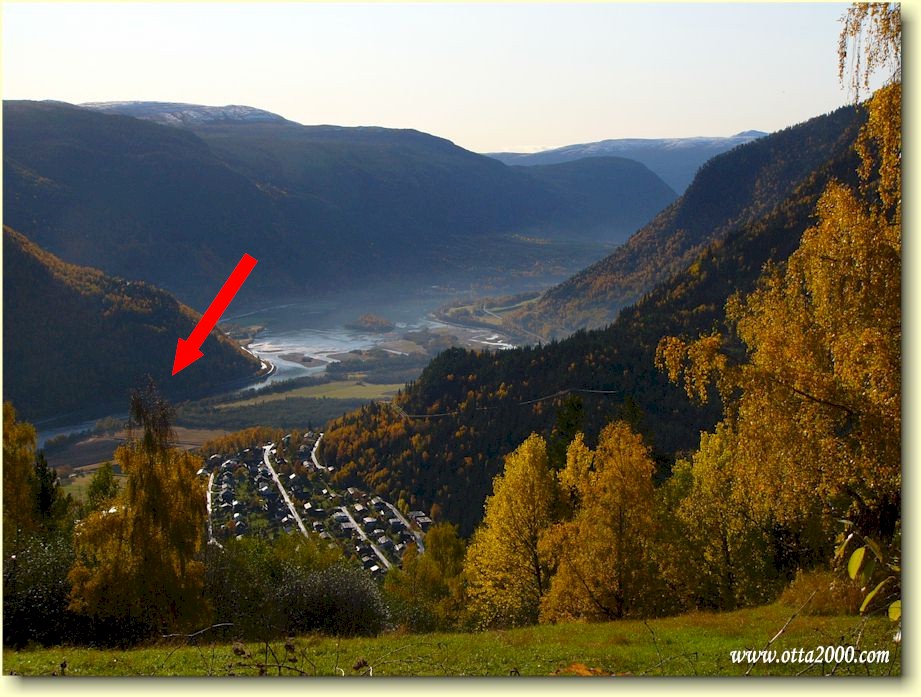 |
| |
|
|
| |
|
|
| |
2)
The Normans - "Gange-Rolv",
ancestor of William the Conqueror |
|
| |
|
|
| |
Rollo/Gange-Rolv Ragnvaldsson (lived around the year
900AD).
He was the son of Rangvald Mørejarl and Hild Rolvsdatter
"Snorri
Sturluson relates in his Kings Sagas that Gange-Rolv
conquered Normandie (in the North-West of France) after
first having wreaked havoc in the Hebrides, the Irish
Sea and France, and that many Norwegians settled in
Normandie with him."
"Sources
tell that he allowed himself to be baptised in 912 and
that he most probably died sometime between 928 and 932.
Rollo's descendants were Dukes in Normandie until 1202.
(Claus Krag in Store norske leksikon)
The photograph shows the statue of Rollo in Rouen
in Normandie, where Gange-Rolv was buried (The Sagas
explain his nickname as being the result of the fact
that he was so tall/heavy that he could not sit on a
horse (Old Norse Gǫngu-Hrólfr, Rolf
who walks)
Gange-Rolv
was
William the First of Normandie's father (893 - 942),
also known as William Longsword. His son was
Richard the First of Normandie (ca 935 - 996), who
was father to
Richard the Second of Normandie (963 - 1027).
|
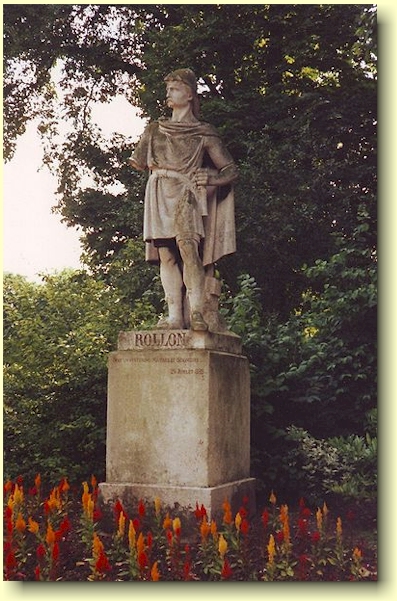
The illustration is borrowed from
Wikipedia. |
| |
|
|
| |
|
|
| |
His son,
Robert the First of Normandie (1000 - 1035) was
father to
William the Conqueror
1027 - 1087) who conquered England in 1066 and became
the ancestor to several English Kings.
The
result of the victory was that for several centuries
French was spoken at the Court in England - and that
many words in today's English language are of French
origin.
William the Conqueror as shown on the
Bayeaux Tapestry.
To the left and right of him his half-brothers Odo
from Bayeaux, and Robert. (Wikipedia)
|
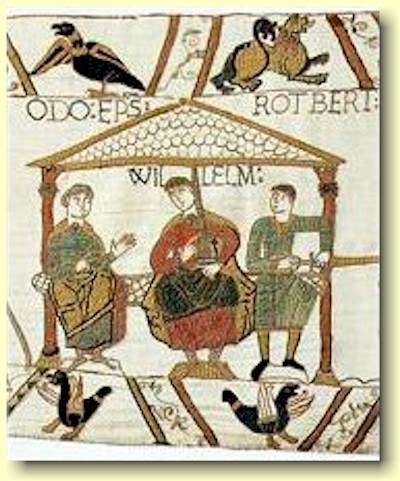
The illustration is borrowed from
Wikipedia. |
| |
|
|
| |
|
|
| |
"Gangerolv" =
Rollo?
Norwegian
and Icelandic history agree that Gangerolv and Rollo
were one and the same person
"The oldest written support for this is to be found
in the Latin Historia Norvegiæ (approx. 1180), which
was written in Norway. Snorri relates in his Kings
Sagas that Gange-Rolv conquered Normandie after
first having wreaked havoc in the Hebrides, the
Irish Sea and France, and that many Norwegians
settled in Normandie with him." (SNL)
"A lively discussion ensued at
the end of the 1800s
as to who Rollo was. The discussion, which was in
part governed by nationality (with Danish and
Norwegian historians on respective sides), gained
special relevance in the period leading up to the
celebration of Normandie's thousand-year Anniversary
in 1911. An important point in the debate, apart
from Rollo's identity, was how the terms
"Norwegians" and "Danes" should be interpreted in
the Middle Age sources, and also where "Danish" or
"Norwegian" settlements had been.
The Danish historian Johannes
Steenstrup (1844-1935) started the debate. His main
argument was based on clear statements by the French
historian Dudo of St. Quentin that Rollo was
Danish...
Norwegian historians - the most important of them
being Gustav Storm, Alexander Bugge and Ebbe
Hertzberg - cast doubt on Dudo's credibility as a
source, and pointed out how completely unreliable
his presentation was otherwise in his writings about
Rollo and Denmark, based on historical and
geographical information which bore no semblance to
reality. They added weight to their argument by
claiming that Rollo had a daughter, Gerloc (Geirlaug),
whose name more closely suggested a Norwegian
connection, and that based also on French reasoning
in writings earlier than Dudo's, there is a
traditional belief that Rollo was Norwegian.
The question as to who Rollo was will never be able
to be answered with finality. But amongst Norwegian
as well as French and British historians, it is now
generally accepted that, based on the available
sources - and given the choice between the two
existing possibilities - most things point
to Norwegian origins. (SNL)
DNA-tests
Investigations are being carried out to clarify this:
Advanced gene technology is to be used to find the
answer. According to the national newspaper Aftenposten,
the research foundation Explico - with financial support
from two major actors in the field of Business, Fred.
Olsen and Christian Sveaas - will exhume two of his
descendants, his grandchild Richard the First and his
great grandchild Richard the Second, in the Autumn of
2010. (The whereabouts of Rollo's own remains is
unknown, but the remains of his two decendants are
entombed in sarcophagi in the town of Fécamp).
Read more about this in
Aftenposten (Sat. 21. Aug. 2010
- in
Norwegian)
|
|
| |
|
|
| |
|
|
| |
|
|
| |
|
|
| |
|
|
| |
|
|
| |
|
|
| |
Clan Sinclair |
|
| |
|
|
| |
|
|
| |
Richard of Saint-Clair and
Brittel of Saint-Clair nevnes begge i
"the
Domesday Book".
The Sinclair family originally came
from Normandie. The name has associations with the place
name Saint-Clair-sur Epte. They originally came to
England with William the Conqueror in 1066.
Angell maintains that the first St. Clair (Sinclair) who
came to Scotland was the son of the daughter of Richard,
Duke of Normandie, who had Gangerolv as one of his
parents (and consequently ancestral connections with the
North-West of Norway
(Angell
p.22).
Richard of Saint-Clair and Brittel of Saint-Clair are
both mentioned in
"the
Domesday Book".
On the right: The Coat of Arms
of the Earl of
Katanes (the Earl of
Caithness), who is today: Malcolm Sinclair, 20th
Earl of Caithness.
|
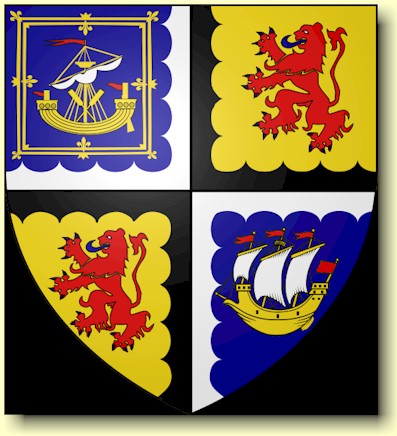
The illustration is borrowed from
Wikipedia |
| |
|
|
| |
|
|
| |
|
|
| |
How did they
come to Scotland? |
|
| |
|
|
| |
William of
Saint-Clair accompanied Saint Margaret of Scotland,
daughter of Edward the Exile, to Scotland in 1068 where
she married Malcolm lll of Scotland.
In appreciation, the Scottish KIng is said to have given
Sinclair "the Barony of
Roslin".
Chief Sir Henry Sinclair, 2nd Baron of Roslin (1060
-1110), led a successful attack on England at the Battle
of Alnwick in 1093.
The photograph on the right shows
Roslin (Rosslyn) Castle. The fortress was built
by the Sinclair family in the 1300s.
|
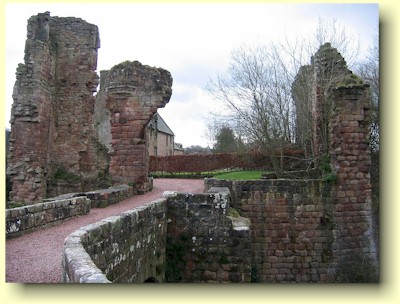
The illustration is borrowed from
Wikipedia |
| |
One of the
first Sinclairs to be mentioned in Scotland was Chief
Henry of Saint-Clair/Sinclair, 3rd Baron of Roslin, who
was awarded a Charter in 1160 granting him the rights to
the Herdmanston land area in Haddington. |
|
| |
|
|
| |
|
|
| |
|
|
| |
Clan
Sinclair in the Orkneys |
|
| |
(coming later) |
|
| |
|
|
| |
|
|
| |
|
|
| |
Clan
Sinclair's castles/fortresses |
|
| |
|
|
| |
Castle Sinclair & Girnigoe
Castle Sinclair Girnigoe is a fortified
structure which lies some five km (3.1 miles) North
of Wick, on the East coast of Caithness. It was
built by
William Sinclair, the second Earl of Caithness,
probably sometime between 1476 and 1496, but before
he died in the Battle of
Flodden in 1513.
It wasn't before the 1600s that the name was changed
from Castle Girnigoe to Castle Sinclair - but both
names continued to be used.
In 1690 the fortress was besieged and destroyed.
In recent years
The Clan Sinclair Trust
has started restoration of the Castle. It is of both
historical and architectural importance. When the
restoration is completed the castle will be one of
the few open to the public which are suitable for
handicapped visitors.
|
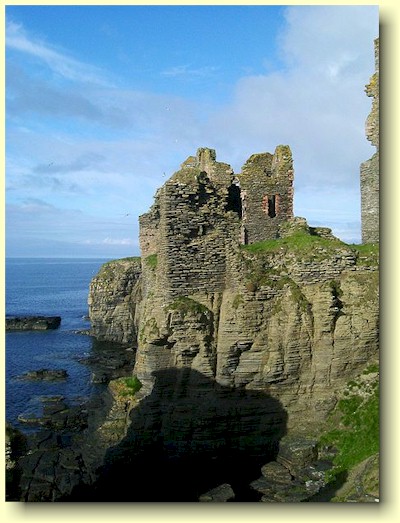
Castle Sinclair Girnigoe is a fortified structure
which lies some five
km (3.1 miles) North of Wick, on the East coast of
Caithness.
The illustration is borrowed from
Wikipedia
|
| |
|
|
| |
|
|
| |
Roslin Castle
The
first Roslin/Rosslyn Castle was built in the 1300s
for
Henry Sinclair, Earl of Orkney.
In
1447? or
1452? the castle was partly destroyed by
fire, and around 1650 it was bombarded by cannon
fire from Oliver Cromwell's forces in Scotland.
Part of the structure has also served as living
quarters in recent times and today's owner, the
Earl of Rosslyn,
also a descendant of the Sinclair family, rents out
the Castle as holiday accommodation.
|
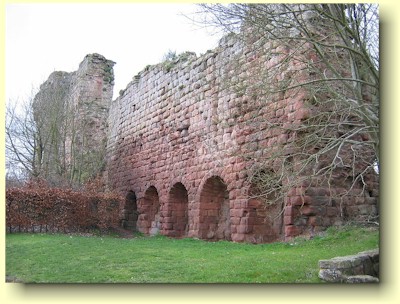
Roslin
(Rosslyn) Castle.
The illustration is borrowed from
Wikipedia |
| |
|
|
| |
|
|
| |
The Castle of Mey
George, the 4th Earl of
Caithness, had "The Castle of Mey" built for his
second son, William Sinclair.
It was owned by the Sinclair family until 1889. In
1952 Queen Elisabeth, the Queen Mother, bought the
property and it has been in the care of "The Queen
Elisabeth Castle of Mey Trust" since 1966.
It is now open to the public for much of the year,
apart from a ten-day period at the end of July,
beginning of August, when Prince Charles and Camilla
are normally in residence.
|
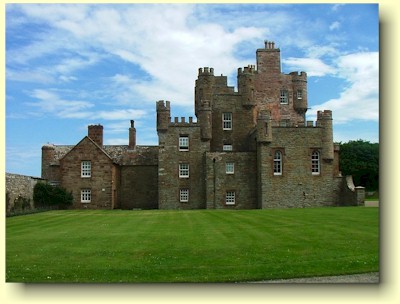
The
Castle of Mey was built between 1566 and 1572,
possibly on the site of an earlier fortification, by
George Sinclair, 4th Earl of Caithness.
The illustration is borrowed from
Wikipedia.
|
| |
|
|
| |
|
|
| |
Rosslyn Chapel |
|
| |
(coming later) |
|
| |
|
|
| |
|
|
| |
|
|
| |
Clan
Sinclair - the 1500s |
|
| |
(coming later) |
|
| |
|
|
| |
|
|
| |
|
|
| |
Clan
Sinclair - the 1600s |
|
| |
(coming later) |
|
| |
|
|
| |
|
|
| |
|
|
| |
George
Sinclair - The Scottish March |
|
| |
(coming later) |
|
| |
|
|
| |
|
|
| |
|
|
| |
Clan
Sinclair - the 1700s |
|
| |
(coming later) |
|
| |
|
|
| |
|
|
| |
|
|
| |
Clan
Sinclair - the Tartans |
|
| |
(coming later) |
|
| |
|
|
| |
|
|
| |
|
|
| |
Clan
Sinclair members in Norway throughout history |
|
| |
(coming later) |
|
| |
|
|
| |
|
|
| |
|
|
| |
Dagens
Chief:
Malcolm
Sinclair,
20th Earl of Caithness |
| |
|
|
| |
Today's
clan chief is a British Conservative politician and
member of the House of Lords as one of the remaining
hereditary peers. The Earl was educated at Marlborough
College and Royal Agricultural College, Cirencester.
Lord Caithness served as a House of Lords government
whip under Margaret Thatcher from 1984 to 1985. He then
moved to the Department of Transport as a Parliamentary
Under Secretary of State, serving until 1986 when he
became a Minister of State at the Home Office. In 1988
he was once again moved, this time to be Minister of
State at the Department of Environment.
In 1989, he became Paymaster-General. |
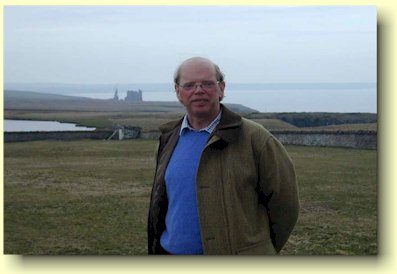
The Earl of Caithness, Malcolm Sinclair
Takk til Ian Sinclair KGCTpl. {Hon.
Archivist and
Historian to the Clan Sinclair Study Centre} for lån av
bildet. |
| |
In 1990, Lord Caithness was again moved to the Foreign
Office as a Minister of State, and then in 1992 back to
the Department of Transport.
|
|
| |
(More (coming later) |
|
| |
|
|
| |
|
|
| |
|
|
| |
Castle Sinclair Girnigoe |
|
| |
Rosslyn Chapel |
|
| |
The Halkirk
Highland Games |
|
| |
Clan Sinclair
in the USA |
|
| |
|
|
| |
Clan Ramsay |
|
| |
(coming later) |
|
| |
|
|
| |
|
|
| |
|
|
|
Background - The
Battle - Myths?
- Significance - Objects - Literature - Scotland
-
Programme2012 |
| |
|
|
| |
|
|
|
|
|
|
|
|
|
| |
|
|
|
|
|
|
|
|
|
| |
|
|
|
|
|
|
|
|
|